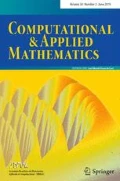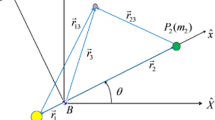Abstract
Solar sails are a type of propulsion that uses solar radiation pressure to generate acceleration. The fundamental goal for any solar sail design is to provide a large and flat reflective film which requires a minimum of structural support mass. This research takes into account the non-sphericity of the central body, the perturbation of the third body and the solar radiation pressure to analyze the behavior of the orbit of a spacecraft when it has a solar sail around Mercury. We present an approach where we plot maps to analyze frozen orbits with longer lifetimes around Mercury. A set of initial conditions, which may contribute with the scientific missions planned to visit the planet Mercury in the next few years, are presented. Frozen orbits were found, i.e., orbits with smaller variation of the orbital elements. An approach is also presented to analyze the effect of the non-sphericity of Mercury on the motion of the spacecraft. In addition, the \(J_{2}\) and \(J_{3}\) zonal terms are also considered, as well as the \(C_{22 }\) sectorial term.














Similar content being viewed by others
References
Brouwer D, Clemence GM (1961) Methods of celestial mechanics. Academic, New York, p 595
Carvalho JPS, Vilhena de Moraes R, Prado AFBA (2010) Some orbital characteristics of lunar artificial satellites. Celest Mech Dyn Astron 108:371–388
Carvalho JPS, Elipe A, Vilhena de Moraes R, Prado AFBA (2012) Low-altitude, near-polar and near-circular orbits around Europa. Adv Sp Res 49:994–1006
Carvalho JPS, Vilhena de Moraes R, Prado AFBA (2013) Dynamics of artificial satellites around Europa. Math Probl Eng 2013:2155–2171 (Article ID 182079)
Elipe A, Lara M (2003) Frozen orbits about Moon. J Guid Control Dyn 26:238–243
Faria MCP (2009) Dinâmica orbital e controle de orientação de um veículo espacial com uma vela solar composta. Tese de doutorado em Engenharia e Tecnologia Espacial/Mecânica Espacial e Controle, INPE
Fu B, Sperber E, Eke F (2016) Solar sail technology—a state of the art review. Progress Aerosp Sci 86:1–19
Giacaglia GEO, Murphy J, Felsentreger T (1970) A semi-analytic theory for the motion of a lunar satellite. Celest Mech 3:3–66
Gomes VM, Domingos RC (2016) Studying the lifetime of orbits around Moons in elliptic motion. Comp Appl Math 35(3):653–661
Kinoshita H (1980) Comment on ’Poisson equations of rotational motion for a rigid triaxial body with application to a tumbling artificial satellite’ by Liu and Fitzpatrick. Celest Mech 21:253–257
Mazarico E, Genova A, Goossens S et al (2014) The gravity field, orientation, and ephemeris of Mercury from MESSENGER observations after three years in orbit. J Geophys Res Planets 119:2417–2436. doi:10.1002/2014JE004675
McInnes CR (1999) Solar sailing: technology, dynamics and mission applications, Springer-praxis series in space science and technology. Springer, Berlin
Meyer WK, Buglia JJ, Dsai PN (1994) Lifetimes of lunar satellite orbits. NASA STI/Recon Technical Report N-TP-3394 94, 27771
Oliveira TC, Prado AFBA (2015) Evaluating orbits with potential to use solar sail for station-keeping maneuvers. Adv Astronaut Sci 153:1699–1718
Rahoma WA, Abd El-Salam FA (2014) The effects of Moon’s Uneven mass distribution on the critical inclinations of a lunar orbiter. J Astron Sp Sci 31(4):285–294
Sehnal L (1959) The influence of the equatorial ellipticity of the Earth gravitational field on the motion of a close satellite. Bull Astronaut Inst Czechoslovak Acad Sci 11:90–93
Stark A, Oberst J, Hussmann H (2015) Mercury’s resonant rotation from secular orbital elements. Celest Mech Dyn Astron 123:263–277
Tresaco E, Elipe A, Carvalho JPS (2016) Frozen orbits for a solar sail around mercury. J Guid Control Dyn 39(7):1659–1666
Tresaco E, Carvalho JPS, Prado AFBA, Elipe A, Vilhena de Moraes R (2017) Effects of the solar radiation pressure and the \(C_{22}\) coefficient in frozen orbits around Mercury (to appear)
Acknowledgements
Sponsored by CNPq—Brazil. The authors are grateful to CNPq (National Council for Scientific and Technological Development) and FAPESP (So Paulo Research Foundation)—Brazil for contracts 306953/2014-5, 420674/2016-0 (CNPq) and 2013/26652-4 (FAPESP).
Author information
Authors and Affiliations
Corresponding author
Additional information
Communicated by Jose Roberto Castilho Piqueira, Elbert E N Macau, Luiz de Siqueira Martins Filho.
Rights and permissions
About this article
Cite this article
Carvalho, J.P.S., Santos, J.C.d., Prado, A.F.B.A. et al. Some characteristics of orbits for a spacecraft around Mercury. Comp. Appl. Math. 37 (Suppl 1), 267–281 (2018). https://doi.org/10.1007/s40314-017-0525-y
Received:
Revised:
Accepted:
Published:
Issue Date:
DOI: https://doi.org/10.1007/s40314-017-0525-y




